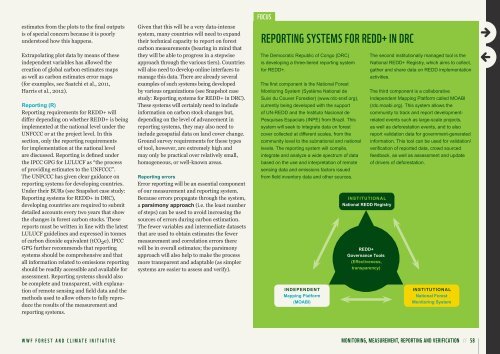WWF Guide to Building REDD+ Strategies
WWF Guide to Building REDD+ Strategies
WWF Guide to Building REDD+ Strategies
You also want an ePaper? Increase the reach of your titles
YUMPU automatically turns print PDFs into web optimized ePapers that Google loves.
estimates from the plots <strong>to</strong> the final outputs<br />
is of special concern because it is poorly<br />
unders<strong>to</strong>od how this happens.<br />
Extrapolating plot data by means of these<br />
independent variables has allowed the<br />
creation of global carbon estimates maps<br />
as well as carbon estimates error maps<br />
(for examples, see Saatchi et al., 2011,<br />
Harris et al., 2012).<br />
Reporting (R)<br />
Reporting requirements for <strong>REDD+</strong> will<br />
differ depending on whether <strong>REDD+</strong> is being<br />
implemented at the national level under the<br />
UNFCCC or at the project level. In this<br />
section, only the reporting requirements<br />
for implementation at the national level<br />
are discussed. Reporting is defined under<br />
the IPCC GPG for LULUCF as “the process<br />
of providing estimates <strong>to</strong> the UNFCCC”.<br />
The UNFCCC has given clear guidance on<br />
reporting systems for developing countries.<br />
Under their BURs (see Snapshot case study:<br />
Reporting systems for <strong>REDD+</strong> in DRC),<br />
developing countries are required <strong>to</strong> submit<br />
detailed accounts every two years that show<br />
the changes in forest carbon s<strong>to</strong>cks. These<br />
reports must be written in line with the latest<br />
LULUCF guidelines and expressed in <strong>to</strong>nnes<br />
of carbon dioxide equivalent (tCO2e). IPCC<br />
GPG further recommends that reporting<br />
systems should be comprehensive and that<br />
all information related <strong>to</strong> emissions reporting<br />
should be readily accessible and available for<br />
assessment. Reporting systems should also<br />
be complete and transparent, with explanation<br />
of remote sensing and field data and the<br />
methods used <strong>to</strong> allow others <strong>to</strong> fully reproduce<br />
the results of the measurement and<br />
reporting systems.<br />
Given that this will be a very data-intense<br />
system, many countries will need <strong>to</strong> expand<br />
their technical capacity <strong>to</strong> report on forest<br />
carbon measurements (bearing in mind that<br />
they will be able <strong>to</strong> progress in a stepwise<br />
approach through the various tiers). Countries<br />
will also need <strong>to</strong> develop online interfaces <strong>to</strong><br />
manage this data. There are already several<br />
examples of such systems being developed<br />
by various organizations (see Snapshot case<br />
study: Reporting systems for <strong>REDD+</strong> in DRC).<br />
These systems will certainly need <strong>to</strong> include<br />
information on carbon s<strong>to</strong>ck changes but,<br />
depending on the level of advancement in<br />
reporting systems, they may also need <strong>to</strong><br />
include geospatial data on land cover change.<br />
Ground survey requirements for these types<br />
of <strong>to</strong>ol, however, are extremely high and<br />
may only be practical over relatively small,<br />
homogeneous, or well-known areas.<br />
Reporting errors<br />
Error reporting will be an essential component<br />
of our measurement and reporting system.<br />
Because errors propagate through the system,<br />
a parsimony approach (i.e. the least number<br />
of steps) can be used <strong>to</strong> avoid increasing the<br />
sources of errors during carbon estimation.<br />
The fewer variables and intermediate datasets<br />
that are used <strong>to</strong> obtain estimates the fewer<br />
measurement and correlation errors there<br />
will be in overall estimates; the parsimony<br />
approach will also help <strong>to</strong> make the process<br />
more transparent and adaptable (as simpler<br />
systems are easier <strong>to</strong> assess and verify).<br />
FoCuS<br />
RePoRtinG SyStemS FoR Redd+ in dRC<br />
The Democratic Republic of Congo (DRC)<br />
is developing a three-tiered reporting system<br />
for <strong>REDD+</strong>.<br />
The first component is the National Forest<br />
Moni<strong>to</strong>ring System (Système National de<br />
Suivi du Couver Forestier) (www.rdc-snsf.org),<br />
currently being developed with the support<br />
of UN-REDD and the Institu<strong>to</strong> Nacional de<br />
Pesquisas Espaciais (INPE) from Brazil. This<br />
system will seek <strong>to</strong> integrate data on forest<br />
cover collected at different scales, from the<br />
community level <strong>to</strong> the subnational and national<br />
levels. The reporting system will compile,<br />
integrate and analyze a wide spectrum of data<br />
based on the use and interpretation of remote<br />
sensing data and emissions fac<strong>to</strong>rs issued<br />
from field inven<strong>to</strong>ry data and other sources.<br />
INDEPENDENT<br />
Mapping Platform<br />
(MOABI)<br />
INSTITUTIONAL<br />
National REDD Registry<br />
<strong>REDD+</strong><br />
Governance Tools<br />
(Effectiveness,<br />
transparency)<br />
The second institutionally managed <strong>to</strong>ol is the<br />
National <strong>REDD+</strong> Registry, which aims <strong>to</strong> collect,<br />
gather and share data on REDD implementation<br />
activities.<br />
The third component is a collaborative<br />
Independent Mapping Platform called MOABI<br />
(rdc.moabi.org). This system allows the<br />
community <strong>to</strong> track and report developmentrelated<br />
events such as large-scale projects,<br />
as well as deforestation events, and <strong>to</strong> also<br />
report validation data for government-generated<br />
information. This <strong>to</strong>ol can be used for validation/<br />
verification of reported data, crowd sourced<br />
feedback, as well as assessment and update<br />
of drivers of deforestation.<br />
INSTITUTIONAL<br />
National Forest<br />
Moni<strong>to</strong>ring System<br />
<strong>WWF</strong> FOREST AND CLIMATE INITIATIVE moni<strong>to</strong>RinG, meaSuRement, RePoRtinG and veRiFiCation // 58

















